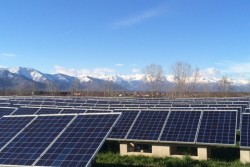How battery systems can integrate renewable energy in smart grids
Wind and solar energy is not constant and therefore a renewables-based society requires smart grids to transport this power from areas where electricity generation is currently high to those where it is low in order to meet demand. And, to keep these grids in balance, electricity storage systems are needed. In several European countries, energy companies, research institutions and local authorities are working together to build such systems. At the end of May 2018, energy producer Eneco (the Netherlands) and Mitsubishi (Japan) inaugurated the currently largest European battery in Jardelund, in the north of Germany. It has a capacity of 48 MW and contains around 10,000 lithium-ion batteries. It is connected to the transport grid operated by Tennet. "Initially the battery will be used for the primary reserve market, where European grid operators purchase the reserve capacity they require to guarantee the 50 Hertz frequency on the grid," says Marc Wegman, director for industrial assets in Germany and the Netherlands at Eneco. "The Jardelund battery can take over the role of primary reserve provider from coal and gas-fired plants. We also investigate possibilities to connect local wind farms to the battery. In the event of overproduction, the energy can temporarily be stored in the battery. For example, this can mean grid operators don't need to ask wind turbine owners to switch off their turbines to avoid overloading." "The battery supports the grid in several ways," underlines Ulrike Hörchens, spokeswoman for Tennet in Germany. "We use it to compensate for the imbalance between generation and consumption. This helps to keep the grid frequency at a stable 50 Hz. We also use it as a source of “reactive” power, important for maintaining the voltage. In the old energy world, these tasks were performed by conventional, central large power plants, using nuclear or fossil fuels. Batteries are important, because they make it possible for new systems to take over the tasks of conventional power plants." A smaller pioneering project is owned by the Swedish energy group Vattenfall. In Cymoedd (Wales, UK) it has constructed a 22 MW energy storage facility at its Pen y Cymoedd 228 MW wind farm, using batteries manufactured by BMW (Germany). It counters power and frequency fluctuations on the grid within a second. In Dilsen-Stokkem (Belgium), energy company Restore has inaugurated an 18 MW battery system. Today, this system is integrated into the spare capacity of Belgian electricity transport grid operator Elia. "Large battery systems can be used to stabilise the frequency and balance the peaks in smart grids. But they can also be used to make specific users grid independent," says Ronnie Belmans, professor in electrical engineering at the KU Leuven university in Belgium and CEO of research centre Energyville (Genk, Belgium). This will most probably be the case of the holiday resort Terhills that will be constructed on the site of a former coal mine in Eisen (Belgium). It will incorporate systems for producing solar energy, such as floating panels that track the sun across the sky. Read more: http://www.bestpaths-project.eu/en/news/how-battery-systems-can-integrate-renewable-energy-in-smart-grids
Keywords
Batteries, energy storage, energy, renewables, energy transport
Countries
Belgium, Germany, Netherlands, United Kingdom



